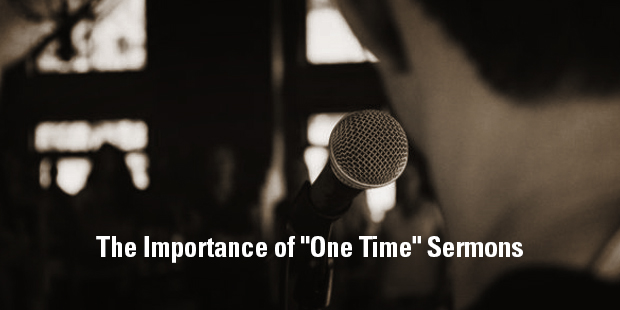
3 Ways to Keep People Listening to Your Sermon
Preaching is tougher than ever these days. For one thing, we can’t assume that people come to our churches with a basic understanding of the Bible like they may have in the past.
But it’s also tougher because of all the media we interact with on a daily basis—from television to email to social media. It seems like someone is always trying to sell us something or convince us about a new idea.
Just open your email, and you’ll likely see a full selection of pitches asking you to buy anything from lunch to a new fishing pole to a vacation. Turn on the television, and the pitching from commercials continues.
Because of this, when unchurched people hear you preach, they assume you’re trying to sell them something. They believe you’re trying to sell them on religion.
That’s not your purpose, but your listeners often don’t know that.
Every week you’re preaching to people who are more skeptical than ever before.
You used to be able to turn up the volume when you had a weak point and keep people’s interest that way. But you can’t do that anymore. It won’t work.
People don’t want you to preach at them. They want you to talk to them. That’s how you keep their attention.
Here are three ways to keep people listening to your sermon:
1. Be open about your struggles and weaknesses.
Don’t try to hide the pain you’ve experienced—or are experiencing right now. Be transparent.
It’s called confessional preaching, and it can increase your credibility. Your confessions will encourage others when they’re going through tough times.
I remember one time, as I preached on anger, I told the church, “You know, it bothers me that sometimes I say the most hurtful things to the people I love the most, such as my wife and kids. Does that bother anyone else?”
Now, I could have just told people that they should be nicer to the people closest to them. I could have made it a command, but that would have immediately put my listeners on the defensive.
When you start with a confession, people will follow along because they see you as someone like them. Your confession will help your message resonate with authenticity and authority.
One key to effective communication is the ability to drop your mask and share real emotions. People will catch your heart. You don’t get this when you yell at them. You get it when your preaching allows others to see what’s going on in your life.
2. Share how you’re making progress.
People grow best through models. Several times in the New Testament, Paul tells readers, “Follow me as I follow Christ.” I used to read that and think I could never do it. It sounded egotistical.
Paul wasn’t saying he was perfect. If you have to be perfect to be a model, we wouldn’t have any models in the world. Frankly, I’d rather have people following me than following someone who isn’t honestly trying to follow Jesus. And so now, I don’t apologize for trying to be a model for others.
We need to follow Jesus’ example in incarnational preaching—where the Word becomes flesh. The way we communicate has changed. Our message isn’t validated by the text alone. It’s validated by the messenger.
Most of the people you’re preaching to aren’t asking, “Is the Bible believable?” They’re asking, “Are you believable?” They want to know whether you have any credibility because if you don’t, they won’t listen to you even if you’re holding up a Bible as you preach.
Our message, on a weekly basis, should be something like this: “Here’s how God got me through another week.”
If you’re not ready to model your message, you’re not ready to preach it.
3. Say it in an interesting way.
I actually work hard on preaching in an interesting manner. The Bible says, “When wise people speak, they make knowledge attractive” (Proverbs 15:2 GNT). It’s foolish to bore people with the Bible.
Too many preachers get stressed out about the idea of entertaining people as they preach. Do you know what the definition of entertainment is? Capturing and holding the attention for a period of time.Do you want your preaching to do that? Of course you do—and you shouldn’t apologize for it! Making your sermons interesting doesn’t mean you have to do a song and dance; rather, it means you help people understand that the Bible is relevant to every little detail of their lives.
To the unchurched, dull preaching is unforgivable, and there is no reason for it. Our message is too important to deliver with a take-it-or-leave-it attitude.
The problem with a boring message is that your hearers won’t just think you’re boring. They’ll think God is boring.
How do you preach in a more interesting way? It’s not about your charisma. You can learn to do it. Start with these three practices.
– Vary your delivery. Nothing is more boring than a monotone preacher who gets stuck on one speed and volume and never comes up for air. Vary the speed and volume of your preaching to make your sermons more interesting.
– Don’t make a point without a picture. People love stories. Pull them from your life. Pull them from the people in your congregation. Pull them from the news.
– Make people laugh. Humor is good for people. It makes a painful truth more palatable. It creates positive emotions like joy and happiness. By the way, you don’t have to tell jokes to be funny. The best humor is usually found in real-life stories.
Every week you get the opportunity to preach God’s Word to people. It’s an extraordinary opportunity. Keeping people engaged in your sermon is how you can get God’s Word into the lives of your listeners, and God’s Word will transform their lives.
That’s certainly worth the effort.

Tags: Communication, Preaching, Preaching Tips, Rick Warren






















